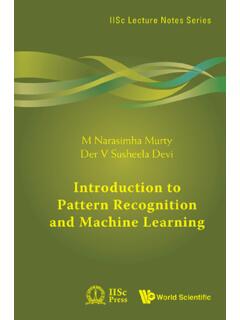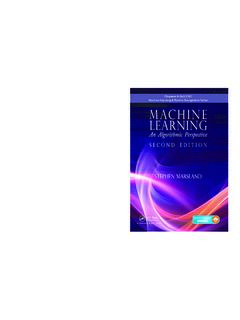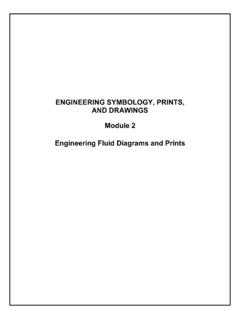Transcription of Fundamentals of Industrial Instrumentation and Process ...
1 Want to learn more? We hope you enjoy this McGraw-Hill eBook! If you'd like more information about this book, its author, or related books and websites, please click here. Fundamentals of Industrial Instrumentation and Process Control William C. Dunn McGraw-Hill New York Chicago San Francisco Lisbon London Madrid Mexico City Milan New Delhi San Juan Seoul Singapore Sydney Toronto Copyright 2005 by The McGraw-Hill Companies, Inc. All rights reserved. Manufactured in the United States of America. Except as permitted under the United States Copyright Act of 1976, no part of this publication may be reproduced or distributed in any form or by any means, or stored in a database or retrieval system, without the prior written permission of the publisher.
2 0-07-146693-2. The material in this eBook also appears in the print version of this title: 0-07-145735-6. All trademarks are trademarks of their respective owners. Rather than put a trademark symbol after every occurrence of a trademarked name, we use names in an editorial fashion only, and to the benefit of the trademark owner, with no intention of infringement of the trademark. Where such designations appear in this book, they have been printed with initial caps. McGraw-Hill eBooks are available at special quantity discounts to use as premiums and sales promotions, or for use in corporate training programs. For more information, please contact George Hoare, Special Sales, at or (212) 904-4069.
3 TERMS OF USE. This is a copyrighted work and The McGraw-Hill Companies, Inc. ( McGraw-Hill ) and its licensors reserve all rights in and to the work. Use of this work is subject to these terms. Except as permitted under the Copyright Act of 1976 and the right to store and retrieve one copy of the work, you may not decompile, disassemble, reverse engineer, reproduce, modify, create derivative works based upon, transmit, distribute, disseminate, sell, publish or sublicense the work or any part of it without McGraw-Hill's prior consent. You may use the work for your own noncommercial and personal use;. any other use of the work is strictly prohibited. Your right to use the work may be terminated if you fail to comply with these terms.
4 THE WORK IS PROVIDED AS IS. McGRAW-HILL AND ITS LICENSORS MAKE NO. GUARANTEES OR WARRANTIES AS TO THE ACCURACY, ADEQUACY OR. COMPLETENESS OF OR RESULTS TO BE OBTAINED FROM USING THE WORK, INCLUDING ANY INFORMATION THAT CAN BE ACCESSED THROUGH THE WORK VIA. HYPERLINK OR OTHERWISE, AND EXPRESSLY DISCLAIM ANY WARRANTY, EXPRESS. OR IMPLIED, INCLUDING BUT NOT LIMITED TO IMPLIED WARRANTIES OF. MERCHANTABILITY OR FITNESS FOR A PARTICULAR PURPOSE. McGraw-Hill and its licensors do not warrant or guarantee that the functions contained in the work will meet your requirements or that its operation will be uninterrupted or error free. Neither McGraw-Hill nor its licensors shall be liable to you or anyone else for any inaccuracy, error or omission, regardless of cause, in the work or for any damages resulting therefrom.
5 McGraw-Hill has no responsibility for the content of any information accessed through the work. Under no circumstances shall McGraw-Hill and/or its licensors be liable for any indirect, incidental, special, punitive, consequential or similar damages that result from the use of or inability to use the work, even if any of them has been advised of the possibility of such damages. This limitation of liability shall apply to any claim or cause whatsoever whether such claim or cause arises in contract, tort or otherwise. DOI: To my wife Nadine for her patience, understanding, and many helpful suggestions during the writing of this text For more information about this title, click here Contents Preface xiii chapter 1.
6 Introduction and Review 1. chapter Objectives 1. Introduction 1. Process Control 2. Definitions of the Elements in a Control Loop 3. Process Facility Considerations 6. Units and Standards 7. Instrument Parameters 9. Summary 13. Problems 13. chapter 2. Basic Electrical Components 15. chapter Objectives 15. Introduction 15. Resistance 16. Resistor formulas 17. Resistor combinations 19. Resistive sensors 23. Capacitance 24. Capacitor formulas 24. Capacitor combinations 25. Inductance 26. Inductor formulas 26. Inductor combinations 27. Summary 27. Problems 28. chapter 3. AC Electricity 31. chapter Objectives 31. Introduction 31. Circuits with R, L, and C 32.
7 V vi Contents Voltage step 32. Time constants 33. Phase change 35. RC Filters 38. AC Bridges 39. Magnetic Forces 40. Magnetic fields 40. Analog meter 42. Electromechanical devices 43. Summary 44. Problems 45. chapter 4. Electronics 47. chapter Objectives 47. Introduction 48. Analog Circuits 48. Discrete amplifiers 48. Operational amplifiers 49. Current amplifiers 53. Differential amplifiers 54. Buffer amplifiers 55. Nonlinear amplifiers 56. Instrument amplifier 56. Amplifier applications 57. Digital Circuits 58. Digital signals 58. Binary numbers 58. Logic circuits 60. Analog-to-digital conversion 61. Circuit Considerations 63. Summary 63. Problems 64.
8 chapter 5. Pressure 67. chapter Objectives 67. Introduction 67. Basic Terms 68. Pressure Measurement 69. Pressure Formulas 70. Measuring Instruments 73. Manometers 73. Diaphragms, capsules, and bellows 75. Bourdon tubes 77. Other pressure sensors 79. Vacuum instruments 79. Application Considerations 80. Selection 80. Installation 80. Calibration 81. Summary 81. Problems 82. Contents vii chapter 6. Level 85. chapter Objectives 85. Introduction 85. Level Formulas 86. Level Sensing Devices 87. Direct level sensing 88. Indirect level sensing 92. Application Considerations 95. Summary 97. Problems 97. chapter 7. Flow 99. chapter Objectives 99. Introduction 99.
9 Basic Terms 100. Flow Formulas 102. Continuity equation 102. Bernoulli equation 103. Flow losses 105. Flow Measurement Instruments 107. Flow rate 107. Total flow 111. Mass flow 112. Dry particulate flow rate 113. Open channel flow 113. Application Considerations 114. Selection 114. Installation 115. Calibration 115. Summary 115. Problems 116. chapter 8. Temperature and Heat 119. chapter Objectives 119. Introduction 119. Basic Terms 120. Temperature definitions 120. Heat definitions 121. Thermal expansion definitions 123. Temperature and Heat Formulas 124. Temperature 124. Heat transfer 124. Thermal expansion 126. Temperature Measuring Devices 127. Thermometers 127.
10 Pressure-spring thermometers 129. Resistance temperature devices 130. Thermistors 131. Thermocouples 131. Semiconductors 133. viii Contents Application Considerations 134. Selection 134. Range and accuracy 134. Thermal time constant 134. Installation 137. Calibration 137. Protection 137. Summary 138. Problems 138. chapter 9. Humidity, Density, Viscosity, and pH 141. chapter Objectives 141. Introduction 141. Humidity 142. Humidity definitions 142. Humidity measuring devices 146. Density and Specific Gravity 149. Basic terms 149. Density measuring devices 150. Density application considerations 153. Viscosity 153. Basic terms 153. Viscosity measuring instruments 154.



![Materials for Engineering [by John Martin]](/cache/preview/5/1/a/3/3/b/5/a/thumb-51a33b5ab7f0a98e5024964f1644b9d4.jpg)






